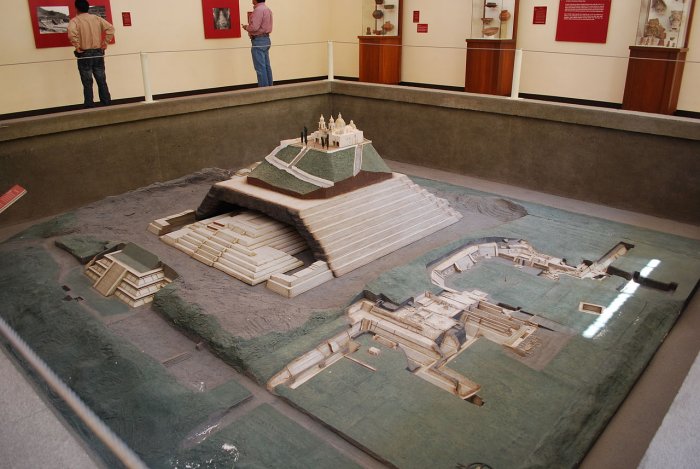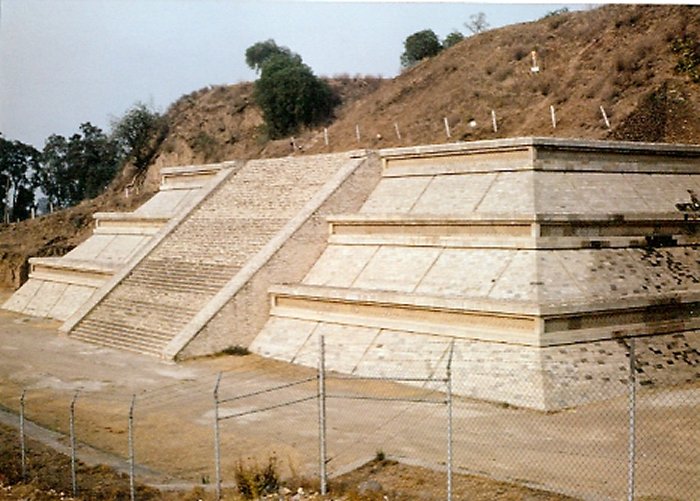Great Pyramid of Cholula Is The Largest In The World Today
A. Sutherland - AncientPages.com - Located in Cholula, Puebla, Mexico, the pyramid stands 55 meters (180 ft) above the surrounding plain, and in its final form, it measured 400 by 400 meters (1,300 by 1,300 ft).
Reconstruction of the Cholula pyramid. Image credit: AlejandroLinaresGarcia - CC BY-SA 4.0
According to the myth, the pyramid was built by a giant named Xelhua of adobe bricks after he escaped a flood in the neighboring Valley of Mexico.
Legend has it, Xelhua one of the seven giants of Aztec mythology who climbed the mountain of the rain god Tlaloc. Later, they built the Great Pyramid at Cholula. The Dominican monk wrote the following report:
"Before the great watershed occurred 4,800 years after the foundation of the world, the country of Anahuac was inhabited by giants, all of whom either died in the great watershed or were turned into fish, except for seven who fled to caves.
"When the waters receded, one of the Giants named Xelhua, nicknamed "The Architect," went to Cholula, where as a monument in honor of Tlaloc, who served as a shelter for him and his six brothers, he built an artificial hill in the form of a pyramid.
"He ordered the bricks to be made in the province of Tlalmanalco, at the foot of the Sierra Cecotl, and in order to deliver them to Cholula, he set up a government of men one by one who passed them from hand to hand. The gods noticed with anger the building, whose top was supposed to reach the clouds. Angered by Xelhuy's bold attempt, they threw fire at the pyramid.
"Many workers died. The work was abandoned and the monument was later dedicated to Quetzalcoatl..."
The Great Pyramid of Cholula (or in nahuatl Tlachihualtepetl), is a temple building in Cholula, in the state of Puebla in Mexico. Its name in nahuatl means "handmade mountain". It was dedicated to the god Quetzalcoatl. In time, Cholula became a mecca for pilgrims from all over Mexico, who flocked to the city to pay homage to the feathered serpent god.
Approximately one hundred years before Christ, the pyramid's construction began. Cholula, by this time, was already one of Mexico's largest cities, having been settled circa 1700 B.C. Various groups carried out the pyramid's structure, and affiliated temples over hundreds of years carried out the pyramid's construction.
Great Pyramid of Cholula, Puebla, Mexico. Image credit: Ernest Mettendorf - Public Domain
Upon the arrival of Cortés, Cholula was Mexico's second-largest city, with a population of up to 100,000 by some estimates. There is some disagreement about what happened next, but it appears that Cortés discovered the alliance between Cholula and Tenochtitlán; perhaps he became aware of a plot against the Spaniards, and he decided to make a pre-emptive attack. The temple was destroyed, and a church was built on the pyramid of Cholula, which the Spaniards believed was only a large hill.
The history of the pyramid is relatively unknown, From the 1930s until today, massive efforts have been made to excavate the pyramid. The pyramid consists of six superimposed structures, one for each ethnic group that dominated it.
The Great Pyramid of Cholula has a base four times the size of Pharaoh Khufu's Great Pyramid of Giza and is the most extensive pyramid base in the Americas.It is the largest pyramid found by archaeologists to date, with a base area four times larger than the Pyramid of Cheops in Egypt. The height of the pyramid is 66 m, and the width is 450 m. It is a very impressive structure.
The history of the pyramid is relatively unknown, but construction began around 300 f.Kr. It is dedicated to the Aztec Quetzalcoatl, and the area has been sacred from the beginning. Scientific explorations of the pyramid began in the 1930s.
Written by – A. Sutherland - AncientPages.com Senior Staff Writer
Updated on October 25, 2022
Copyright © AncientPages.com All rights reserved. This material may not be published, broadcast, rewritten or redistributed in whole or part without the express written permission of AncientPages.com
Expand for referencesMore From Ancient Pages
-
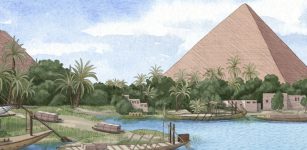 Evidence The Khufu Channel Aided The Construction Of The Giza Pyramids Found – Scientists Say
Archaeology | Aug 31, 2022
Evidence The Khufu Channel Aided The Construction Of The Giza Pyramids Found – Scientists Say
Archaeology | Aug 31, 2022 -
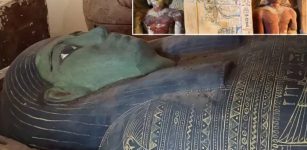 New Trove Of Treasures, Funerary Temple, 50 Sarcophagi Unearthed In Saqqara, Cairo
Archaeology | Jan 18, 2021
New Trove Of Treasures, Funerary Temple, 50 Sarcophagi Unearthed In Saqqara, Cairo
Archaeology | Jan 18, 2021 -
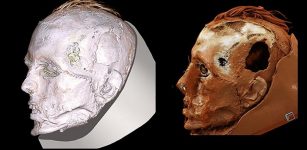 Never-Before-Seen Face Of A Tattooed Tashtyk Man Hidden Behind A Gypsum Death Mask Revealed
Archaeology | Jul 17, 2020
Never-Before-Seen Face Of A Tattooed Tashtyk Man Hidden Behind A Gypsum Death Mask Revealed
Archaeology | Jul 17, 2020 -
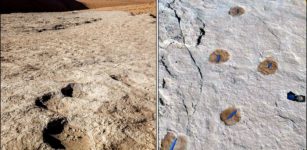 120,000-Year-Old Human Footprints Discovered In Saudi Arabia
Archaeology | Sep 18, 2020
120,000-Year-Old Human Footprints Discovered In Saudi Arabia
Archaeology | Sep 18, 2020 -
 How Saul, A Farmer Boy Became The First King Of Israel
Featured Stories | Jan 20, 2022
How Saul, A Farmer Boy Became The First King Of Israel
Featured Stories | Jan 20, 2022 -
 Was The Discovery Of Biblical Abel’s Giant Grave In Syria Covered-Up?
Ancient Mysteries | Oct 28, 2014
Was The Discovery Of Biblical Abel’s Giant Grave In Syria Covered-Up?
Ancient Mysteries | Oct 28, 2014 -
 On This Day In History: Battle Of Rudau Was Fought – On Feb 17, 1370
News | Feb 17, 2017
On This Day In History: Battle Of Rudau Was Fought – On Feb 17, 1370
News | Feb 17, 2017 -
 On This Day In History: Parachute Jump From 1,000 m Above Paris Is Recorded – On Oct 22, 1797
News | Oct 22, 2016
On This Day In History: Parachute Jump From 1,000 m Above Paris Is Recorded – On Oct 22, 1797
News | Oct 22, 2016 -
 4,000-Year-Old Serpent-Shaped Wooden Stick Unearthed in Southern Finland
Archaeology | Jun 30, 2021
4,000-Year-Old Serpent-Shaped Wooden Stick Unearthed in Southern Finland
Archaeology | Jun 30, 2021 -
 407-Million-Year-Old Plant Fossil Challenges Long-Held Theory On Fibonacci Spirals Found In Nature
Evolution | Jun 22, 2023
407-Million-Year-Old Plant Fossil Challenges Long-Held Theory On Fibonacci Spirals Found In Nature
Evolution | Jun 22, 2023 -
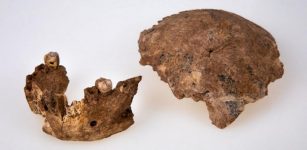 New Type Of Early Previously Unknown Human Discovered In Israel
Archaeology | Jun 29, 2021
New Type Of Early Previously Unknown Human Discovered In Israel
Archaeology | Jun 29, 2021 -
 Vikings’ Encounters With Peculiar White-Dressed Humanoids And Cave Dwellers In Unknown Lands Described In Norse Sagas
Featured Stories | Sep 5, 2024
Vikings’ Encounters With Peculiar White-Dressed Humanoids And Cave Dwellers In Unknown Lands Described In Norse Sagas
Featured Stories | Sep 5, 2024 -
 Ancient DNA Reveals Easter Island’s Population Collapse Never Occurred
DNA | Sep 16, 2024
Ancient DNA Reveals Easter Island’s Population Collapse Never Occurred
DNA | Sep 16, 2024 -
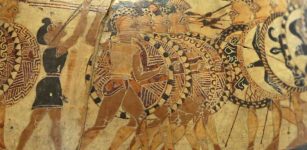 Why Didn’t The Spartans Build City Walls?
Civilizations | May 30, 2022
Why Didn’t The Spartans Build City Walls?
Civilizations | May 30, 2022 -
 Mystery Of The Anglo-Saxon Burial At Lowbury Hill May Soon Be Solved
Archaeology | Mar 7, 2023
Mystery Of The Anglo-Saxon Burial At Lowbury Hill May Soon Be Solved
Archaeology | Mar 7, 2023 -
 Scientists Search For North America’s ‘Atlantis’ – Submerged Landscapes In The Gulf Of Mexico Studied
Archaeology | Jul 2, 2024
Scientists Search For North America’s ‘Atlantis’ – Submerged Landscapes In The Gulf Of Mexico Studied
Archaeology | Jul 2, 2024 -
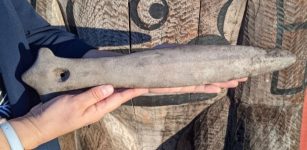 Unique Ancient Coast Salish War Club Accidently Discovered In British Columbia Backyard
Archaeology | Mar 22, 2022
Unique Ancient Coast Salish War Club Accidently Discovered In British Columbia Backyard
Archaeology | Mar 22, 2022 -
 What Was The True Meaning Of Pankration And Other Ancient Games
Archaeology | Sep 11, 2021
What Was The True Meaning Of Pankration And Other Ancient Games
Archaeology | Sep 11, 2021 -
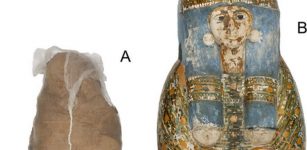 New Study Reveals Rare Mortuary Treatment Of Egyptian Mummy
Archaeology | Feb 8, 2021
New Study Reveals Rare Mortuary Treatment Of Egyptian Mummy
Archaeology | Feb 8, 2021 -
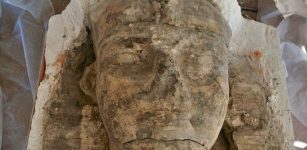 Giant Blocks For Sphinx-Shaped King Amenhotep III Colossi Uncovered In Luxor, Egypt
Archaeology | Jan 23, 2022
Giant Blocks For Sphinx-Shaped King Amenhotep III Colossi Uncovered In Luxor, Egypt
Archaeology | Jan 23, 2022

